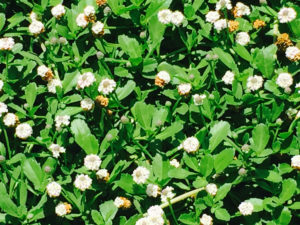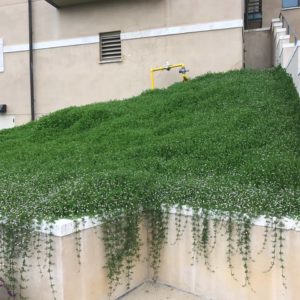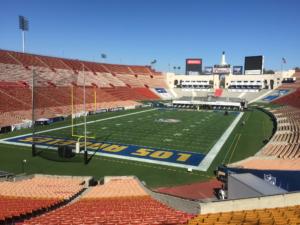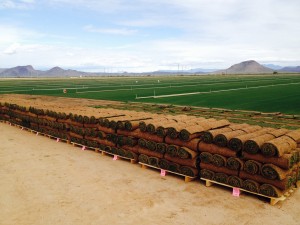Apr
Tips For Mowing Your California and Arizona Sod
Maintaining a lush, green lawn in the arid climates of Southern California and Arizona can be quite a challenge. It’s totally achievable though, with the right approach. Mowing plays a pivotal role in keeping your lawn healthy and attractive. Here are some tips on the best way to keep your lawn beautiful when mowing:
1. Choose the Right Mower: It is crucial to select the appropriate mower to achieve optimal results. For Southern California and Arizona, where lawns often consist of warm-season grasses like bermudagrass, Zoysia grass, or St. Augustine grass, consider using a rotary mower. These mowers are well-suited for cutting thicker grass types commonly found in warmer climates.
2. Adjust Mowing Height: Maintaining the correct mowing height is vital for the health of your lawn. In hot and dry climates, it’s recommended to keep your grass slightly taller to provide shade to the soil and retain moisture. Adjust your mower’s cutting height to leave the grass blades around 2 to 3 inches tall. Taller grass also helps to inhibit weed growth by shading the soil.
3. Follow the One-Third Rule: Adhere to the one-third rule that states
you should never remove more than one-third of the grass blade’s height in a single mowing session. Cutting more than this can stress the grass and make it more susceptible to drought and diseases. Aim to mow your lawn regularly to maintain a consistent height.
4. Mow When the Grass is Dry: Mowing wet grass can lead to an uneven cut and cause clumping, which can smother the grass beneath. Additionally, wet grass is more prone to tearing, resulting in an unhealthy appearance. Therefore, it’s best to mow your lawn when the grass is dry, preferably in the morning or late afternoon when temperatures are cooler.
5. Sharpen Mower Blades Regularly: Sharp mower blades ensure clean cuts, promoting healthier grass growth. Dull blades tear the grass instead of cutting it cleanly, leaving ragged edges that are more susceptible to disease. Check your mower blades regularly and sharpen or replace them as needed to maintain optimal cutting performance.
Alternate Mowing Patterns: Changing your mowing pattern regularly helps prevent soil compaction and encourages upright grass growth. Consider mowing in different directions each time you mow to avoid creating ruts and uneven wear on your lawn.
6. Leave Grass Clippings on the Lawn: Grass clippings are a valuable source of nutrients for your lawn. Instead of bagging them, leave them on the lawn to decompose. This practice, known as grasscycling, returns essential nutrients like nitrogen back into the soil, promoting healthy grass growth. For more information, visit westcoastturf.com
No CommentSep
The Importance of Water in the Hotter Months When Laying your Arizona or California Sod
With the intense heat of the summer, it can be an intimidating task to lay sod. Often, the ideal time to lay sod is early to mid-fall, or in the spring. For many people though, summer is the perfect time to get it done.
Summer can be a hard time for new sod, since it’s hot and the sod can be vulnerable to drought. But with the right strategy and lots of water, you can install warm or cool season sod any time of the year. Here’s how:
- Test your soil. Your soil’s health determines the overall health of your grass and testing to make sure it will thrive is the right way to a successful lawn. It helps to balance your soil’s pH so when you apply nutrients found in fertilizers, your grass is able to absorb those. When soil’s pH is off, nutrients can’t be absorbed as effectively and fertilizer you buy may be a waste of money. Taking a soil analysis and sending it to a laboratory is an affordable way to test.
- Choose the right sod for your lawn. Does your lawn have a lot of shade? What grass colors, textures, and physical aspects do you want in your sod? These are questions to ask yourself when choosing. Of course, the climate you live in – in our case, dry desert – plays a huge part in the selection as well. Luckily, this part of the process can be made easy by consulting one of the experts at West Coast Turf.
- Measure the planting area. This will help you determine how much sod you need to order and is crucial whether you’re laying sod in the summer, fall, or spring. There are many apps and tools to calculate how much surface area you’ll need to cover and how much sod is needed.
- Kill and remove old grass. When you install new sod, it’s important that all currently existing grass and other vegetation be removed.
- Prep soil and level. This step is especially important for laying sod in the summer months. Proper site preparation makes it easier for new grass roots to penetrate deeply and evenly—this allows your sod to establish quickly during the stressful heat of the summer. Although you will still need to water your lawn a lot during the summer, deep roots will make the lawn denser and drought resistant, allowing for more efficient use of water and nutrients. A dense lawn will outcompete weeds and resists insects and disease a little better as well.
- Lay the new sod. It should remain on the pallet a very short time during summer installations as this will cause the sod to dry out. If you notice the sod is heating up on the pallets, unstack them and spray them with water.
- Water and fertilize. It is crucial in the summer months to make sure you are watering your grass adequately!
Please let us know if you have any questions or want to talk about installing new sod! Visit https://westcoastturf.com for more info.
Comments Off on The Importance of Water in the Hotter Months When Laying your Arizona or California SodApr
Changes in Water Restrictions in California
 We have all read an article or two lately about the need to cut back on water used outdoors for lawns, trees, and shrubs. We are in a time when water supply is low, and we are caught between trying to keep our homes cooler by having a lawn and using too much water to keep it green. There will always be two sides to this issue as some see lawns and plants as a waste of water and others understand the benefit to the environment. As is the case in politics a blog post or article is not going to change one’s mind one way or the other but being opened to change and learning from each other will help us find a middle ground. Today I am going to talk about ways to reduce water for your turfgrass while keeping the grass healthy, and still providing the benefits to the environment.
We have all read an article or two lately about the need to cut back on water used outdoors for lawns, trees, and shrubs. We are in a time when water supply is low, and we are caught between trying to keep our homes cooler by having a lawn and using too much water to keep it green. There will always be two sides to this issue as some see lawns and plants as a waste of water and others understand the benefit to the environment. As is the case in politics a blog post or article is not going to change one’s mind one way or the other but being opened to change and learning from each other will help us find a middle ground. Today I am going to talk about ways to reduce water for your turfgrass while keeping the grass healthy, and still providing the benefits to the environment.
Grass selection is becoming more and more important. Let us start by examining the difference between warm and cool season grasses. Here in the southwest you can expect to use 30% more water by using a cool season grass when compared to a warm season grass. Cool season grasses grow best between 60-75 degrees whereas warm season grasses grow best between 90-105 degrees. Picking a warm season turfgrass for your area can save a significant amount of water and allow you to curtail water use longer during hot, dry periods. Swapping out a tall fescue lawn for a drought tolerant bermudagrass is much cheaper than you think and it will save water and put money back in your pocket.
The next part of grass selection is determining the right warm season grass for you. Breeders have been working overtime for years to come up with more drought tolerant grasses and they have been very successful. Some of the grasses on the market right now for reducing water are Kurapia (best drought tolerance), Tahoma 31 (second best), Tiftuf (3rd) Santa Ana, Paspalum, and Zoysia (coming soon to WCT). Kurapia is a ground cover that can be maintained on 50-60% replacement of evapotranspiration and even less if you want to slow the growth and put the grass into a state of dormancy during the hot summer. Studies have shown Tahoma 31 to use slightly less water than Tiftuf its closet competitor in the drought market and 20% less water than older bermudagrass varieties. Selecting the right turfgrass will enable your lawn to use less water and maintain drought tolerance through the hot summer.
How much water does grass need to survive? This is a loaded question, and you will get several different answers but on average 1.25” of water per week during the hottest part of the summer will keep your lawn healthy, thriving, and growing. Can you water less than 1.25” and have a good lawn? Absolutely! You could maintain your lawn with a once-a-week deep irrigation cycle during the summer months to keep the plant healthy and alive. The drought tolerant varieties will put your lawn into a state of pseudo dormancy, but the turf will still provide the same environmental benefits. I know for many having a green lawn is important but sometimes its not possible based on available water. In this situation I advise using a product like Endurant Turf Paint to give the lawn the desired color during periods of water reduction. Since the lawn will not be growing much the paint should last 45-60 days.
Raise your mowing height during the summer. The shorter you maintain your lawn, the shallower the root system will be for the plant. Most warm season grasses can be maintained between half and inch and one and a half inches. These are the optimal ranges but do not be afraid to raise the height to two inches and save even more water.
Water infiltration is extremely important. If your soil is a hard pan and water sheets off the ground every time you water, there is some work to do. Grass loves a deep watering which can happen all at once or broken up in the cycle/soak method. This means running 10-15 minutes and then letting it soak for an hour or more before running the second half of the cycle. If you cannot run more than a few minutes of water without runoff its time to aerate and open the soil. This will relieve compaction and allow water to freely get into the soil.
Irrigation systems save time, water, and money. Putting in a smart timer that calculates evapotranspiration and tests soil moisture will help keep water use down and drastically lower your budget. These smart devices calculate real time weather, plant needs, and soil data. You can set them to use 70-80% of ET to keep your lawn growing. Many cities offer free irrigation clocks and soil moisture monitor tools so check with your city and see what is available.
There are so many great options on the market right now to save water and allow you to have a healthy lawn. Remember that a lawn does not have to be bright green to be healthy. No one wants to give up their lawn and no one will have to if we all use some conservation methods. If you have any questions on any varieties send me an email and I will be happy to help you out. For more information about us, visit: westcoastturf.com
Click here for:
-Jay, Mr. Wise Grass
Comments Off on Changes in Water Restrictions in CaliforniaMar
When Should I Start to Spring Transition My Lawn to Bermudagrass?
I’d like to go over some common questions I have received through the blog in the last few weeks and see if it can help others with some of the same concerns. I always encourage everyone to send over your lawn questions and I will get back to you as soon as I can.
When should I start to transition my lawn back to bermudagrass?
I always recommend starting the process slowly in March and ramping up in April so your lawn has transitioned by May. I know that was a mouth full, but the truth is it’s not a short process unless you chemically transition your lawn. In March its ideal to start to gradually lower your mowing height and remove some of the turf canopy. This is not a scalp, this is lowering the height so the bermudagrass can breathe and get some sunlight. By mid-March you should be mowing two times per week and starting to see some thinning in the ryegrass. By thinning I mean bermudagrass leaves are starting to show between the ryegrass blades. Currently there is no need to fertilize the ryegrass, its time to back off on nutrition until bermudagrass season. In early April you can lightly verticut or even lightly power rake the lawn to remove some of the ryegrass giving way to bermudagrass. The more sunlight you can get in the grass, the faster you will transition. If the ryegrass remains extremely thick and lush you can expect it to provide excessive spring shade slowing down the bermudagrass. When soil temperatures reach 64 degrees (around April 15th) go ahead and apply ammonium sulfate 21-0-0 at 5 pounds per 1000 SF to jump start your bermudagrass. Continue mowing two times per week and gradually lowering your heights until you see the bermudagrass take over.
Spring Transition, keep lowering the height…..
Can I still put down pre-emergent for broadleaves?
Most of the grassy weeds and broadleaves are now germinating so putting down the preemergent will not yield the results you’re looking for. At this juncture its best to spot spray weeds depending on the type. Make sure the product is labeled for the weed you’re trying to control and can safely be used on bermudagrass. Grassy weeds use different chemicals than broadleaves and not all chemicals are safe and effective so check with specialty stores for better products.
What can I do to repair the urine damage from my dogs? Read the rest of this entry »
Comments Off on When Should I Start to Spring Transition My Lawn to Bermudagrass?Jan
Winter Lawn Care for your California and Arizona Sod
The weather stays relatively pleasant and sunny in desert landscapes in Southern California and Arizona, even in the winter. But once the suns dips down, temperatures drop down drastically. What can you do to keep your natural lawn looking beautiful in the colder months? Here are some tips.
Keep mowing!
Mowing your grass can sometimes fall by the wayside during the winter months. It’s recommended that you follow a semi-regular schedule and continue to mow the grass until you see the growth slow. A good rule of thumb is to keep your grass around 2 to 2.5 inches tall throughout the autumn months, since the grass could start to mat above 3 inches. It’s important to keep it the right length, since overgrowth can cause mold or diseases, and cutting it too short hinders the grass’s ability to to store food for growth.
Sustain Growth by Watering
Even though the temperatures are cooler and there is more precipitation this time of year, it’s still important to continue to water your natural grass. Following a consistent watering schedule encourages growth. Do make sure to adjust your automatic sprinklers so they don’t over-irrigate and cause fungal growth.
Don’t forget to weed in the winter!
Weeding may seem like more of a warm weather chore, but it’s just as important to keep up with it in the winter.
West Coast Turf is the expert on all things grass. Let us know what questions you have about keeping your natural turf looking amazing! Visit our website at www.westcoastturf.com.
Comments Off on Winter Lawn Care for your California and Arizona SodAug
KURAPIA GROUNDCOVER SOD BACK IN STOCK!
Great news! We now have our Kurapia drought tolerant groundcover sod back in stock in California and Arizona!
What they’re saying about Kurapia…….
- “After extensive research and investigation, Kurapia was chosen for the following reasons: aesthetics, growth habit, drought tolerance, erosion control, weed suppression, disease resistance, maintenance aspects, and foremost and most importantly–water conservation–with the reduction of water usage. Kurapia met all of these expectations and more. I believe Kurapia will revolutionize the landscape industry
Mark Runk
G&R Engineering
El Cajon, CA
Comments Off on KURAPIA GROUNDCOVER SOD BACK IN STOCK!
Aug
Attention Landscape Architects! We Are Now Offering ZOOM Educational Opportunities!
These are trying times, but that doesn’t mean we have to stop learning. West Coast Turf is now offering virtual Zoom educational opportunities for landscape architects!
Include your whole office! Find out about the newest varieties including the exciting Kurapia sod natural turfgrass alternative ground cover. It’s drought tolerant, unique, versatile, and beautiful. There are some great new native grasses that look spectacular. We also can update you on our old standbys such as West Coaster Fescue, Santa Ana, Bandera Bermuda, and Tifgreen that are tried and true.
Call or e-mail us today to schedule your presentation–760/340-7301 or danielle@westcoastturf.com. The presentation takes about an hour, and we are able to answer any questions you might have on natural turfgrass varieties or Kurapia sod ground cover for your next project.
We miss you and are excited to “see” you again virtually! Contact us today!
Comments Off on Attention Landscape Architects! We Are Now Offering ZOOM Educational Opportunities!Sep
Pre-Overseeding Tips for Your Lawn
I would like to start by congratulating everyone on making through another California and Arizona summer. I know we still have a couple months of triple digit temperatures, but the worst should be behind us at this point. As we move into September our morning temperatures will start to feel less painful, but remember your warm season grass is loving this weather–especially your California and Arizona sod. I have started to field questions regarding fall overseeding and I want to tell you to hit the brakes. Don’t just tap the brakes, slam on the brakes. You will see ryegrass hit the stores in the next week but walk away or buy it and sit on it until temperatures really drop. Today I want to discuss prep for the fall, and how to get your grass ready to overseed. This won’t be a tutorial on how to overseed, but instead some pointers of what to do before you overseed.
Comments Off on Pre-Overseeding Tips for Your LawnJun
Arizona Sod Summer Watering Tips
1. The grass doesn’t spring back up after you step on it.
Jan
Weeds and Your Arizona and California Lawns.
We haven’t had a very wet winter but with the recent rains we’re going to start to see the emergence of some winter annual weeds. The good news is the weeds that are starting to emerge are easy to control.
There are some types such as annual bluegrass, crabgrass, and nutsedge that are a little more complicated but timing pre-emergent herbicide applications can save you a lot of headaches with weed control. In this blog I will go over various weeds and some ways to control them as well as discuss herbicide timing. Weed control management is a function of several different factors but some of the things you can do to keep your lawn healthy are maintain the proper mowing height, not overwatering, fertilize monthly, and aerate the turf when the soil becomes compacted. These items right here can be the difference between weeds slowly emerging in your lawn and taking over your lawn. A healthy lawn will push out weeds and keep them to a minimum. If you have very few weeds emerge during the year chemical applications are usually unnecessary and weeds can be pulled by hand as they appear.
Comments Off on Weeds and Your Arizona and California Lawns.






